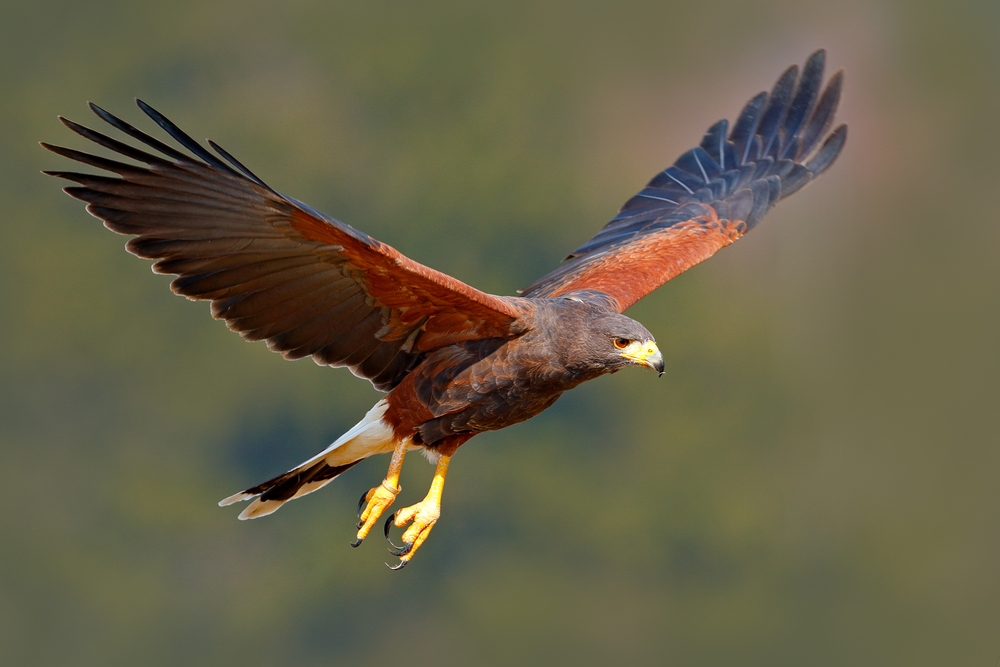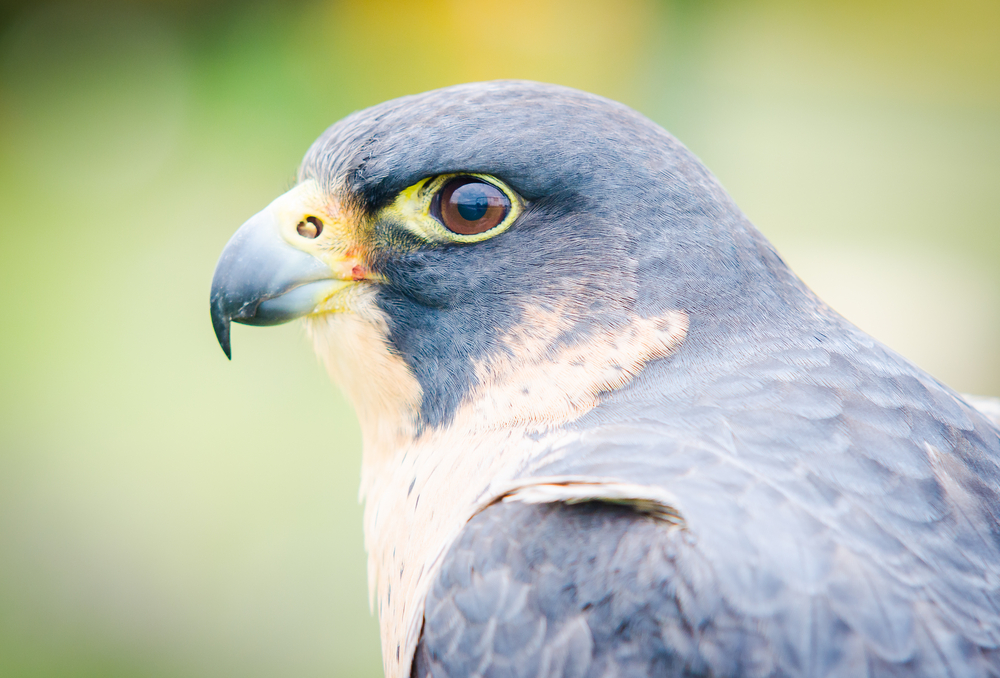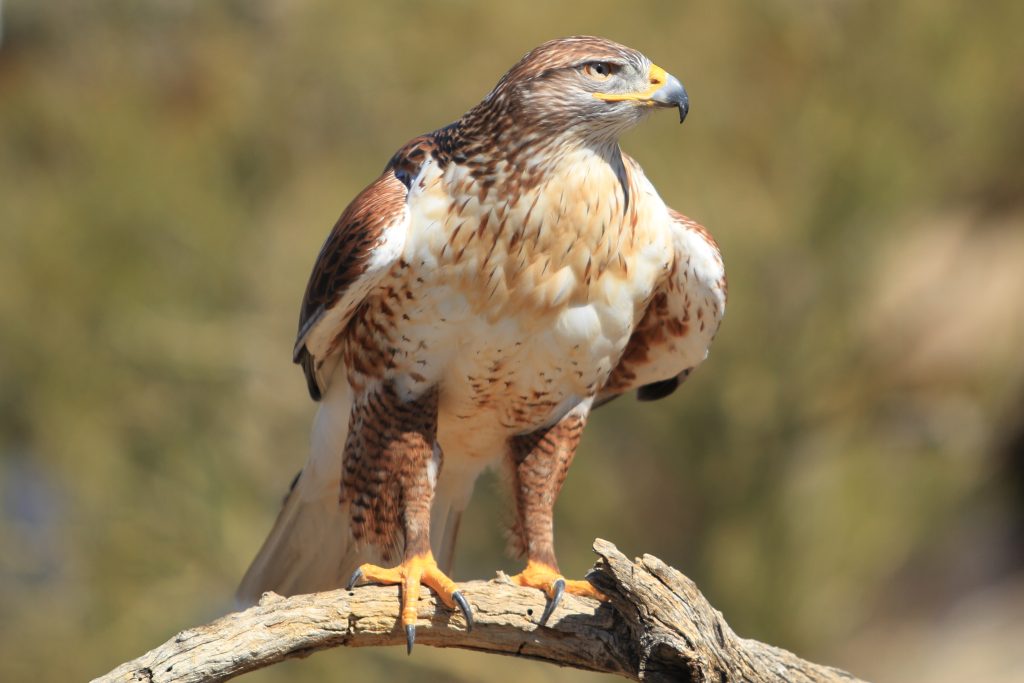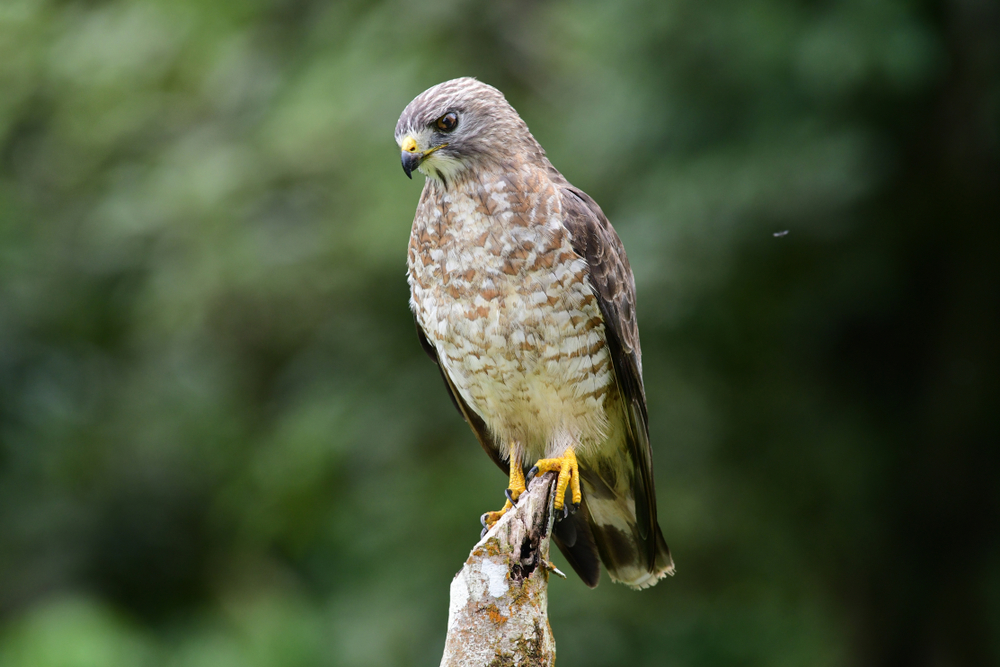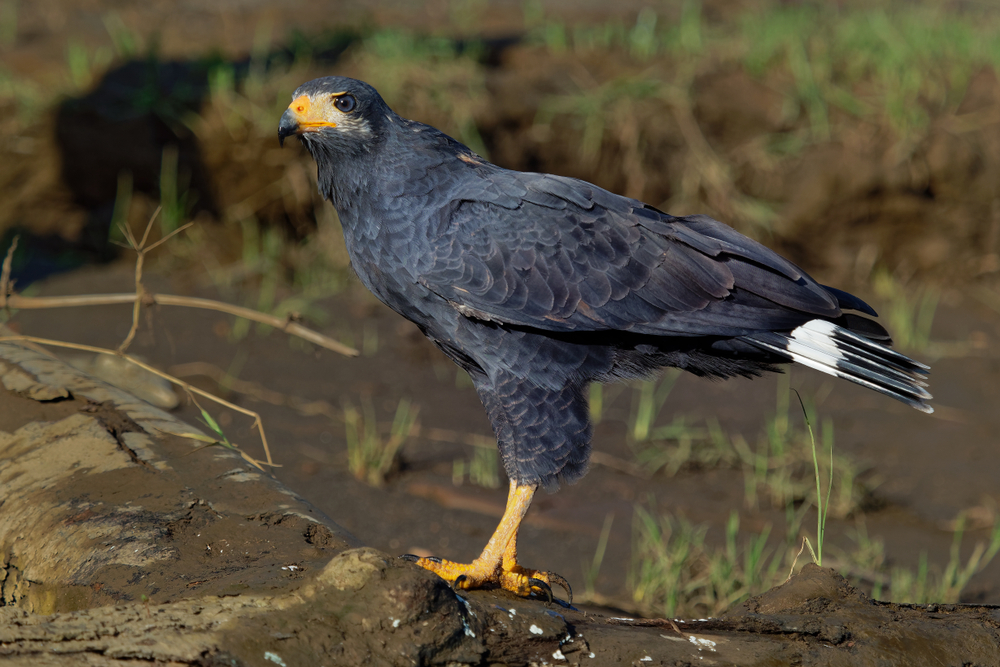The Harris’s Hawk’s closest relatives are other members of the Parabuteo and Buteo groups, particularly the White-tailed Hawk (Geranoaetus albicaudatus) and Galapagos Hawk (Buteo galapagoensis). However, its social behavior makes it quite distinct from most raptors.
About
The Harris’s Hawk (Parabuteo unicinctus) is a unique raptor of the Accipitridae family, widely recognized for its cooperative hunting behavior—rare among birds of prey. Native to the Americas, its range extends from the southwestern United States through Central and South America, favoring deserts, scrublands, and semi-open habitats with scattered trees or cacti.
Medium to large in size, Harris’s Hawks measure 46 to 59 centimeters (18 to 23 inches) in length with a wingspan of 103 to 120 centimeters (40 to 47 inches). They are strikingly patterned, with dark chocolate-brown plumage accented by rich chestnut shoulders, thighs, and wing linings. Their tail is black with a broad white base and tip, making them distinctive in flight. Yellow legs and cere further highlight their bold appearance.
Unlike most solitary raptors, Harris’s Hawks live and hunt in groups, often consisting of related individuals. Working cooperatively, they flush, chase, and corner prey such as rabbits, hares, ground squirrels, and birds, greatly increasing their hunting success. This social hunting strategy has earned them the nickname “wolves of the sky.”
Breeding pairs build nests in tall trees, cliffs, or cacti, often reusing and enlarging nests over successive years. Females usually lay two to four eggs, and the group helps care for the chicks, with subordinate hawks assisting in feeding and defense. This cooperative breeding system enhances chick survival in harsh desert environments.
Harris’s Hawks are currently listed as Least Concern, with stable populations, though habitat loss and human disturbance pose local threats. They are also highly valued in falconry for their intelligence, trainability, and willingness to work alongside humans, making them one of the most popular hawks used in the sport.
Graceful, intelligent, and highly social, Harris’s Hawks stand out as one of the most fascinating raptors in the world.
Physical Characteristics
The Harris’s Hawk (Parabuteo unicinctus) is a medium-to-large raptor native to the Americas, well known for its social hunting behavior and striking plumage.
-
Plumage: Adults are dark brown overall with chestnut-red shoulders, thighs, and wing linings. The rump and undertail coverts are white, and the tail is tipped with a broad white band—features that make them easy to identify in flight. Juveniles are streaked with more mottled brown and less contrast.
-
Face: The bill is sharply hooked, bluish-gray at the base with a yellow cere. Eyes are dark brown, and facial skin around the cere is also yellow.
-
Body: Sleek yet powerful, with a long body built for endurance and agility in open desert and scrub habitats.
-
Wings: Long, broad, and rounded, providing both strong flapping power and soaring ability.
-
Tail: Long and broad with a distinctive white base and terminal band, often flashed during flight.
-
Feet: Yellow and robust, with long toes and sharp talons adapted for gripping and dispatching prey.
Size:
-
Length: About 18 to 24 in (46 to 60 cm).
-
Wingspan: Between 40 to 47 in (100 to 120 cm).
-
Weight: Ranges from 1.2 to 3.6 lbs (0.6 to 1.6 kg), with females substantially larger than males.
The Harris’s Hawk’s chestnut shoulders, white-marked tail, and tendency to hunt in cooperative groups make it one of the most distinctive and easily recognized raptors of the Americas.
Reproduction
The reproductive cycle of the Harris’s Hawk is unusual among raptors, as it often involves cooperative breeding within social groups.
-
Mating and Courtship:
-
Harris’s Hawks are monogamous, but many pairs are assisted by additional adults (often offspring from previous years) in raising young.
-
Courtship includes aerial displays, soaring together, and food offerings from male to female.
-
They breed year-round in warmer climates but most actively from March to June.
-
-
Nesting:
-
Nests are built in tall trees, cacti, or man-made structures, usually 10–30 ft (3–9 m) above ground.
-
Constructed from sticks and lined with grasses, moss, and softer materials.
-
Cooperative groups may build multiple nests within a territory.
-
-
Egg Laying and Incubation:
-
The female usually lays 2 to 4 eggs, pale bluish or whitish in color.
-
Incubation lasts 31 to 36 days, mostly by the female, though males and helpers may assist.
-
-
Chick Development:
-
Chicks hatch covered in white down and are brooded continuously in the first days.
-
Both parents (and sometimes helpers) feed the chicks small prey pieces until they can eat whole items.
-
-
Fledging and Independence:
-
Young fledge at about 40 to 45 days of age.
-
Even after fledging, juveniles may remain dependent on the group for several weeks as they practice hunting.
-
Harris’s Hawks’ cooperative breeding system—unusual among raptors—greatly increases reproductive success and survival in the harsh desert habitats they occupy.
Lifespan
The Harris’s Hawk (Parabuteo unicinctus) is a social raptor of the Americas whose cooperative lifestyle contributes to its survival and longevity.
-
Lifespan in the Wild:
Harris’s Hawks typically live 10 to 15 years in the wild, though some individuals may reach up to 20 years under favorable conditions. Juvenile mortality is high, with many not surviving their first year due to predation or inexperience in hunting. -
Lifespan in Captivity:
In falconry and wildlife facilities, Harris’s Hawks often live longer, sometimes 20 to 25 years, because of steady food supplies, protection from predators, and medical care.
Threats to the Harris’s Hawk:
-
Habitat Loss: Urbanization, agriculture, and desert habitat degradation reduce nesting and hunting territories.
-
Predation: Eggs and chicks are preyed upon by snakes, raccoons, and larger raptors such as Great Horned Owls.
-
Human Hazards: Collisions with vehicles, fences, and powerlines are frequent in desert regions where they hunt near roads.
-
Food Availability: Declines in rabbit, hare, and small bird populations affect reproductive success.
Despite these threats, Harris’s Hawks remain widespread and are listed as a species of Least Concern, with stable or increasing populations in much of their range. Their adaptability to cooperative hunting and breeding gives them an advantage over many solitary raptors.
Eating Habits
The Harris’s Hawk is a versatile predator, best known for its cooperative hunting behavior, which is rare among raptors.
-
Diet:
Their primary prey includes small mammals (rabbits, hares, rodents), birds (quail, doves, and smaller species), and reptiles (lizards and snakes). They may also take large insects when other prey is scarce. -
Foraging Strategy:
Unlike most hawks, Harris’s Hawks often hunt in family groups of 2 to 6 individuals. This cooperative strategy allows them to capture larger prey and improves hunting success in desert habitats where prey may be patchy. -
Hunting Behavior:
Groups use teamwork, with some birds flushing prey while others ambush. They are also known to perch in “towers,” with one hawk on top of another, to increase hunting visibility.
When hunting alone, they rely on swift chases and powerful dives. -
Feeding the Young:
Prey is carried to the nest, where parents (and often helpers) tear food into small pieces for chicks. Juveniles are fed communally by the entire group. -
Seasonal Variation:
In desert regions, diet shifts with availability. Rabbits and hares dominate in cooler months, while reptiles and birds are more common in summer.
The Harris’s Hawk’s cooperative hunting makes it unique among raptors and contributes to its reputation as the “wolf of the sky,” showcasing one of the most advanced social hunting strategies of any bird of prey.
Uniqueness
The Harris’s Hawk (Parabuteo unicinctus) is one of the most distinctive raptors in the Americas, with traits rarely seen in other hawks:
-
Cooperative Hunters: Unlike most raptors, Harris’s Hawks hunt in family groups, using teamwork to flush, chase, and ambush prey—earning them the nickname “wolves of the sky.”
-
Social Structure: They live in complex social groups with a dominant breeding pair and helpers, often offspring from previous years, that assist in hunting and raising young.
-
Stacked Perching: Known for their unique “stacking” behavior, where multiple hawks perch on top of each other on a single branch, enhancing visibility of prey.
-
Desert Adaptation: Harris’s Hawks are well adapted to arid habitats, thriving in deserts, scrublands, and savannas where other large raptors struggle.
-
Human Bond: Their intelligence, trainability, and social nature make them highly valued in falconry, where they are often used for cooperative hunting alongside humans.
-
Distinctive Plumage: Their dark brown body with chestnut shoulders, thighs, and a white-tipped tail makes them easy to distinguish from other North American hawks.
The Harris’s Hawk’s rare cooperative lifestyle, desert resilience, and close relationship with humans make it one of the most unique and charismatic raptors in the world.
Be the First to Share Photos of This Species.
FAQ’s
1. What is the species closest to the Harris’s Hawk?
2. How does the Harris’s Hawk compare to other hawks?
Unlike most hawks, which are solitary hunters, the Harris’s Hawk is highly social and cooperative, often hunting in groups like a pack of wolves. They are medium-sized, smaller than Ferruginous Hawks but larger than Cooper’s Hawks, and are easily recognized by their chestnut shoulders and white-tipped tail.
3. What national parks provide an opportunity to see the Harris’s Hawk?
Harris’s Hawks thrive in desert and scrub habitats of the American Southwest and Latin America. Parks where they can be observed include:
-
Saguaro National Park (Arizona) – desert habitat stronghold.
-
Big Bend National Park (Texas) – along canyons and desert flats.
-
Organ Pipe Cactus National Monument (Arizona) – prime desert viewing.
-
Sonoran Desert reserves (Mexico and U.S.) – widespread presence in protected desert ecosystems.
These areas highlight the Harris’s Hawk’s unique desert adaptations and cooperative hunting lifestyle.



































































